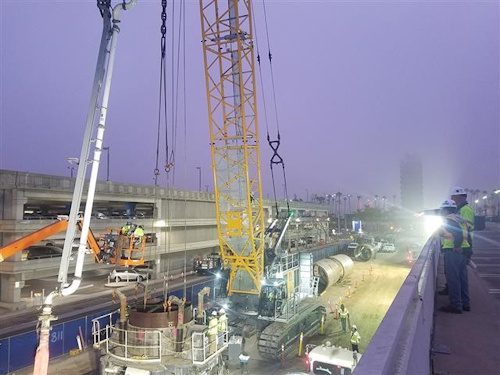While business across most industries has screeched to a halt or slowed to a crawl amid the COVID-19 outbreak, executives at airports across the U.S. are pushing forward with billions of dollars in construction and improvement projects.
While business across most industries has screeched to a halt or slowed to a crawl amid the COVID-19 outbreak, executives at airports across the U.S. are pushing forward with billions of dollars in construction and improvement projects.
“Shutting down is not an option,” says Glenn Januska, airport director at Casper/Natrona County International (CPR) in Wyoming. The airport is at various stages of four major infrastructure projects, including the reconstruction of an aircraft rescue and firefighting (ARFF) training facility that serves Wyoming and surrounding states.
CPR is also preparing to bid out a $3.5 million project to expand and renovate its gate holding area; and it is continuing with the design phase of replacing the terminal roof and constructing a new quick-turnaround facility for car rental operators. In addition, the airport recently bid out the purchase of a combination plow/broom vehicle for snow removal.
“It’s interesting to discuss large capital projects as our flights decrease and PFC revenue that is needed to pay for [a project like the gate holding expansion] is taking a hit,” Januska told Airport Improvement via email. “But my board met and said to move forward. It’s a project to meet our long-term needs, and, ironically, we are expecting some pretty good prices right now.”
Many Projects Still Taking Off
CPR is not alone. Los Angeles International Airport (LAX) is proceeding with no fewer than five construction projects, says Peter Aarons, Global Practice lead for the West Region Aviation Division of Burns & McDonnell, an engineering, design and construction firm. Although stay-at-home orders have been issued throughout California, construction workers at LAX, San Francisco International (SFO) and other airports can continue working because they are deemed “essential to infrastructure.”

Work continues on a new automated people mover system at Los Angeles International.
In Idaho, Lewiston-Nez Perce County Regional Airport (LWS) kicked off the first phase of a $7 million runway reconstruction project in mid-March, as COVID-19 spread nationwide. Airport Director Mike Isaacs reports that contractors are on track to finish by the original mid-June completion date.
At Louisville Muhammad Ali International (SDF), executives have actually accelerated portions of SDF Next, the Kentucky airport’s $400 million effort to remodel/revamp areas inside the terminal and out. Executive Director Dan Mann notes that contracts for a parking lot expansion and the implementation of a new automated park assist system were awarded in early March, when impacts of the new coronavirus were evident.
With parking lots nearly empty because of a steep decline in customer traffic, the airport authority decided to move ahead aggressively with the full parking lot project rather than complete the work in phases over the next year or more as originally planned.
“This is more about solving the issues we had and the issues we will have in the future, and taking advantage of the fact that those lots are vacant,” Mann explains.
The airport is also seizing opportunities associated with the delay of the Kentucky Derby from the first week of May to Labor Day weekend. Smaller terminal construction projects planned for later this year are being tackled now because the traditional influx of travelers for the big race will occur months later than usual.
Longer-Term Effects
Looking further ahead, Mann expects other elements of the large SDF Next initiative to be placed on hold due to lost revenue from the drop in commercial air travel. “The negative piece of this is when we look out three years or longer, we’re going to have less operating cash, PFCs are going to drop off, and so we start to evaluate some terminal projects.”
Within the next five years, the airport was planning to invest in boarding bridges, replace HVAC systems, expand TSA checkpoints and build a federal inspection station. Those projects likely will be postponed two or three years, Mann says. Still, he’s grateful for the influx of $10 billion in emergency funds for airports that was part of the recently passed CARES Act (Coronavirus Aid, Relief and Economic Security Act).
Mann considers it “pretty amazing” that Congress acted so quickly to help airports. That said, he also credits industry leaders for convincing legislators about the urgency that was needed.
Aarons, of Burns & McDonnell, reports that airports are using insight gained during previous crises such as 9/11 to help navigate the current COVID-19 pandemic. “This is totally different, but a lot of [airport executives] are being positive and optimistic, taking an outlook of ‘this, too, shall pass.’ ”
Aarons also references the economic recession in 2008, when airlines cut back, just as they are today, but U.S. airports continued to build and modernize because they had a predictable source of federal funding. He notes that some projects Burns & McDonnell is supporting in the West region have been “moved to the right,” but are expected to restart no later than early 2021.
“Hats off to these airport agency clients that are managing through this. They’ve got their eye on the big picture,” he remarks. “They’ve already thought through that whether this lasts a few more weeks or longer than that, we still need to be prepared coming out of this. I commend them for keeping the progress moving forward. We’re going to come out of this one way or another, and they’re going to need these projects built.”



